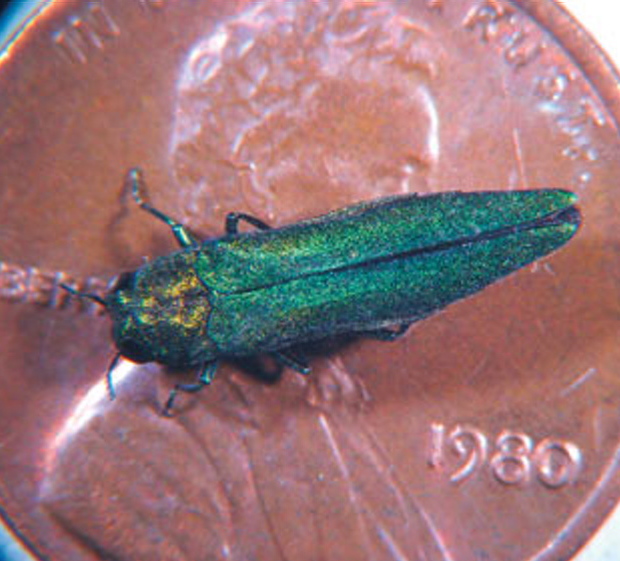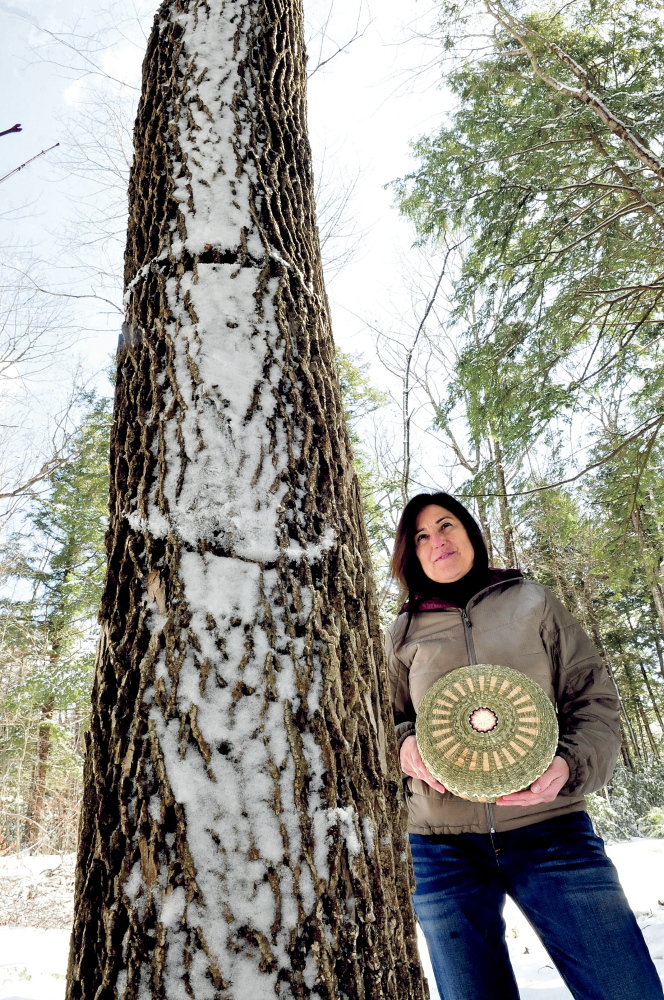A handful of Maine basket makers, many of them Wabanakis with ancient ties to the area, are forming a lonely line of defense against an invasive beetle that threatens to rob them of their livelihood.
They fear that the eventual arrival in Maine of the emerald ash borer could destroy what they’ve worked hard to create using the ash tree.
Over the past 20 years, the story of traditional basket makers has been one of triumph in the face of adversity, according to Theresa Secord of Waterville, president of the Maine Indian Basketmakers Alliance.
In 1993, the alliance was founded because tribal basket making seemed to be on the cusp of dying out altogether. Only 53 basket makers could be identified, many of them older women scraping together an income by selling their wares through gift shops at a price of about $30 each.
Today, the organization’s membership includes 200 basket makers, while the average age has dropped from 63 to 40, a sign that young members of the state’s four tribes – Passamaquoddy, Penobscot, Maliseet and Micmac – collectively known as Wabanakis, are rediscovering an ancient cultural art form.
Secord, a member of the Penobscot tribe, is one of those who have passed on ancestral skills to her own children.
“It’s really important to us as a family and as a tribe,” she said.
Meanwhile, the price of the baskets has increased dramatically, from $30 to about $300 in most cases, with some commanding prices of $3,000 or more, enough to provide a sustainable income to families.
Many of the basket makers didn’t know it, but the entire time they were patiently rebuilding their ranks, a ruinous threat was hurtling toward them from the Midwest. It remains to be seen whether the state’s oldest cultural art form can withstand what scientists say is the most destructive forest pest ever documented in North America.
“We’ve gone from a great comeback to almost losing it all to a little green beetle from Asia,” Secord said. “The entire resource could be lost.”
UNDER ATTACK
To make a basket, one needs ash, a hardwood tree that also is used for firewood and other products, such as canoe paddles, snowshoes, ax handles and furniture. The Maine Forest Service estimates that about 6.7 million cords are harvested each year, at a value of about $140 million. The basket makers use black ash, which also is referred to as brown ash in the state.
In the early 1990s, just when Maine’s basket makers were getting organized to preserve their relation to the ash, the emerald ash borer, a nasty beetle with a taste for the trees, first showed up in the Detroit metropolitan area in Michigan. U.S. Department of Agriculture scientists suspect that the beetles were introduced in wooden crates or pallets made from infested ash trees in Asia, the home range of the borer.
In the short time period since its discovery, the invasive pest has chewed its way through hundreds of millions of ash trees on a destructive rampage through 22 states. Researchers say the dollar value of the damage is in the billions of dollars, yet that might pale in comparison to the ripple effect created by subtracting a common hardwood variety from forest ecosystems.
When the bugs attack a population of trees, the survival rate is less than 1 percent, according to Nate Siegert of New Hampshire, a forest entomologist with the U.S. Forest Service and a leading national expert on the emerald ash borer.
Trees usually can pull from an impressive bag of tricks to fend off predators – pine trees smother predatory insects in sap, while ash trees repel bugs by building up foul-tasting compounds or growing extra bits of wood that literally crush a larva before it matures.
American ash trees use these methods to shrug off attacks from local bugs, while Asian ash trees use them to repel the emerald ash borer successfully.
But because the American trees and Asian beetles evolved on different continents, local ash trees are ill-prepared to deal with the threat, Siegert said.
“It’s almost like our species of ash trees don’t realize they’re being attacked until it’s too late for it to defend itself,” he said.
Left unchecked, the beetle larvae eat into the wood beneath the bark, cutting off the tree’s flow of nutrients, while the emerging adults attack the tree’s leaves before laying more eggs, a cycle that inevitably leads to the death of the tree.
PEOPLE FACILITATE SPREAD
The speed with which the beetles have traveled across the country and into the Northeast has confounded scientists. While the bugs are thought to have been introduced in the early 1990s, they weren’t noticed until around 2002.
In just 12 years, they have popped up in 22 states, a rate of growth that simply wouldn’t be possible if the beetles were traveling under their own power.
The culprit is human – people carrying beetle-infested firewood are thought to be the reason the bug has popped up in states far from Michigan, including Colorado and Georgia.
“On its own, it only spreads one to two miles a year at the most,” Siegert said. “But someone with a pickup truck of firewood can move it hundreds or thousands of miles at a time.”
In 2005, a few years after the beetles were first discovered, Philip Bell, the U.S. Department of Agriculture’s Animal and Plant Health Inspection Service regional manager for the insect, predicted Maine wouldn’t see one until 2030. Even in 2007, Bell told the Wisconsin state senate that the agency hoped to contain the bug to Michigan, Illinois, Indiana and Ohio. Instead, the spread has been rampant. By 2012, the metallic-green bug had been found in Connecticut and Massachusetts. In 2013, it was documented in New Hampshire for the first time.
The basket makers are one part of an anti-borer coalition that includes university researchers, entomologists and forestry officials. For the last several years, the faculty at the University of Maine’s Senator George J. Mitchell Center and Maine’s Sustainability Solutions Initiative has hosted an annual symposium at the university’s Orono campus. Last year, the event drew 65 concerned people from a variety of state and federal agencies, as well as entomologists and Wabanakis.
The turnout was impressive, Secord said, but it pales in comparison to what is needed.
“It’s a feeble attempt at stopping what is really a force,” she said. “These invasive pests are nearly unstoppable.”
Secord said the discussion in the basket-making community already has shifted from how to keep the beetle out of the state to how to live alongside the beetle.
“Our work is to help basket makers adapt to what we know will occur,” she said. “We know they will lose access to a significant portion of the resource.”
BEETLE BRIGADE
Can Maine become the first state to manage the emerald ash borer successfully?
There are reasons to think that it might escape the wholesale devastation other states have seen over the last decade.
“I think we’re in a much better place today than we were when we first found this 10 years ago,” Siegert said. “We have an idea about how to look for it and how to manage it.”
Maine’s geography helps. The state is partially protected by its ocean boundary on one side, and its northern half is so sparsely populated that human transport opportunities are relatively rare.
And because Maine is dominated by evergreens, with ash trees comprising just 6 percent of the total hardwood forest, ash trees tend to exist in isolated pockets rather than huge contiguous blocks. In order to eliminate ash trees from the state, beetles would have to travel from pocket to pocket through territory that is not hospitable to them.
In 2010, a bill sponsored by state Rep. Jeff McCabe, D-Skowhegan, was signed into law that made it illegal for firewood to be transported into Maine from other states. At the time, McCabe said he was motivated by the combined threat of the Asian long-horned beetle and the emerald ash borer.
Another factor favoring Maine is the recent harsh winter, which struck a blow against the beetles, potentially buying the Wabanakis more time. When the temperature drops to 20 below zero, the mortality rate among sleeping beetle larvae is 50 percent, with more beetles dying as the temperature gets colder.
Secord and Siegert have co-authored a study on the effect of submerging fallen ash trees and found that a tree kept under water for eight weeks will kill any larvae on it. The study was done in recognition of a traditional storage system in which Wabanakis would submerge their logs in ponds or streams before weaving their strips into baskets.
Matt Hongoltz-Hetling can be contacted at 861-9287 or at:
mhhetling@centralmaine.com
Twitter: @hh_matt
Send questions/comments to the editors.



